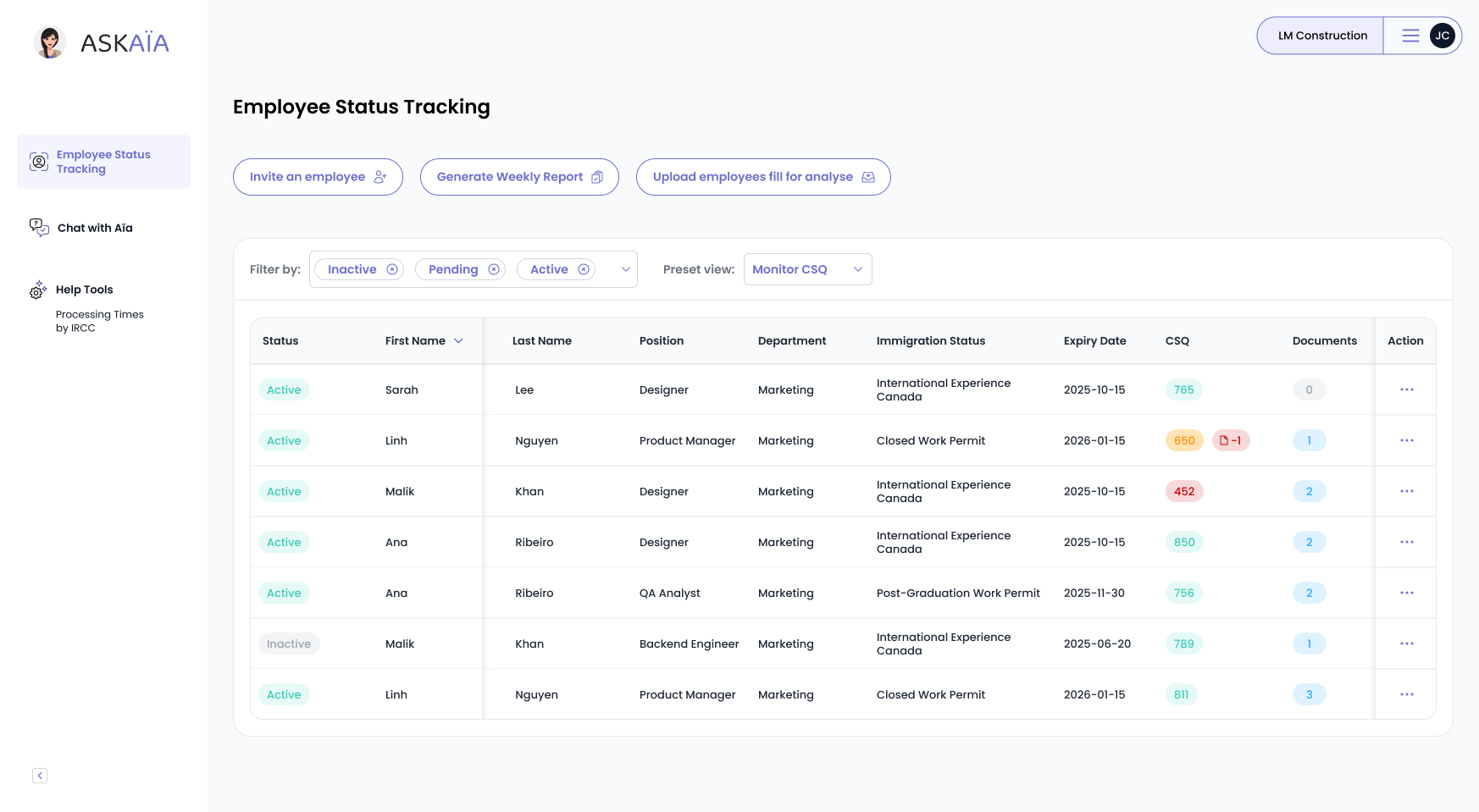Every year, dozens of Canadian employers face this reality due to non-compliance with the Temporary Foreign Worker Program. In the past year alone, enforcement actions have surged 55%, targeting companies across transportation, construction, and healthcare.
This guide explains exactly what happens when you’re found non-compliant—and how you can protect your business.
What you will find in this article
Significant Financial Penalties
You could face fines of up to $100,000 per violation. Multiple breaches can quickly exceed $1 million in penalties. These amounts depend on the severity, intent, and whether your company has prior violations.
| Violation Type | Maximum Fine per Violation | Potential Suspension Period |
| Wage Discrepancy | $100,000 | Up to 2 years |
| Missing or Incomplete Records | $100,000 | Up to 2 years |
| Misrepresentation | $100,000 | Up to 10 years |
| Obstructing an Inspection | $100,000 | Up to 10 years |
Suspension of Authorizations and Contracts
Employers may be suspended temporarily or permanently from the program. Suspensions can range from 1 to 10 years, depending on the severity and frequency of violations. During this period, you will not be able to submit new LMIA applications or obtain work permits for any positions, which can quickly derail critical operations.
For companies with seasonal or project-based staffing needs, even a short suspension can trigger cascading impacts—project delays, cancelled contracts, and loss of revenue. Beyond the operational disruption, suspension often damages relationships with clients, suppliers, and staffing partners who rely on your ability to maintain a steady workforce. Reputational harm can also linger long after the suspension ends, making it harder to recruit qualified talent or win new business opportunities.
Inclusion on the Public Non-Compliance List
Your company’s name, address, and details of each violation are published on the official Government of Canada non-compliance registry, which is publicly accessible online. This public exposure doesn’t just create embarrassment, it can result in a cascade of negative consequences.
Clients and partners often review this list during contract negotiations or procurement processes. If your business is listed, you may be disqualified from bids or lose preferred vendor status. Existing customers may reconsider their relationships, especially in sectors like healthcare, logistics, and construction where compliance is often a contractual requirement.
Additionally, your employees and job candidates can see these listings, which may undermine confidence in your organization’s integrity and reduce your ability to attract qualified talent. Media outlets and industry associations sometimes monitor the registry and report enforcement actions, further amplifying reputational damage.
Over 270 employers have been listed since the registry began, highlighting how widespread enforcement has become. In some cases, companies remained on the list for multiple years if corrective actions were incomplete, extending the reputational impact well beyond the initial penalty period.
Real Examples of Sanctions
In 2024, transportation companies were fined a combined $2.4 million for wage discrepancies and missing records. Construction firms were suspended from the program for up to five years. Over 270 employers have been listed on the official non-compliance registry since its creation, showing how widespread these penalties have become.
The impact is real and lasting. For example, a healthcare provider was fined for hiring staff without proper credential verification, and a tech company was penalized for misclassifying software developers as exempt positions, resulting in six-figure fines in 2023.
Impact on Your Business Operations
You could lose essential employees, face delayed projects, and risk losing contracts that require proof of compliance. Even a short suspension can disrupt your workforce and profitability. You may also face indirect costs such as legal fees, higher insurance premiums, and losing preferred supplier status with clients. Over time, you may also face difficulty attracting qualified talent, increased scrutiny on future LMIA applications, and mandatory corrective action plans imposed by authorities before you can resume hiring.
Quick Self-Check: Could You Be at Risk?
- Are your employee records current and complete?
- Do wages match prevailing rates and contracts?
- Could you respond to an inspection in 48 hours?
If you answered “no” to any of these, your organization may be vulnerable.
What to Do If You Receive a Notice
If you find yourself in this situation, here are clear steps to follow:
- Act quickly. Deadlines are often tight.
- Collect your documents. Contracts, payroll, recruitment files.
- Cooperate fully. Avoiding communication increases penalties.
- Get expert help. Professional guidance can reduce the impact.
If you receive a notice, you may also have an opportunity to appeal. Employers can provide additional evidence, submit written arguments, or request a review within a specified deadline, usually 30 days from the notice date. Prompt action is critical to preserve your rights and prepare effectively for next steps.
Take Action Today
Concerned about fines or suspensions? Book a free immigration compliance call with the experts on our team.

Let’s get your demo started
Book a demo
You May Also Like
These Related Stories

Top Compliance Risks in Key Canadian Industries
Compliance failures don’t look the same in every sector. From trucking fleets to healthcare providers, each industry faces unique vulnerabilities that …

The Hidden Costs of Non-Compliance: Beyond the Fine
Many Canadian employers assume that immigration compliance is only about avoiding fines. But regulatory breaches often lead to severe indirect costs, …

Why Employers End Up on Canada’s Non-Compliance List
Every year, dozens of Canadian employers find themselves publicly listed as non-compliant with the Temporary Foreign Worker Program (TFWP) or the Inte …


